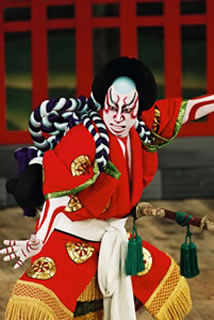
Image: Shochiku
|
The word 'Kabuki' literally means song, dance and acting and is a combination of all three arts with the main emphasis on the last. Its origins can be traced back to the beginning of the 17th century.
Toward the end of the 17th century Kabuki began to take on its present form, ceasing to be a mere dance drama and developing a repertory of first-class plays ranging from those with a historical background to those depicting contemporary life. The actors, who were all male, gradually formed themselves into professional families who handed down their acting skills from generation to generation.
Within the strongly hierarchical ranks of the families of kabuki performers, 32 year-old Ebizo Ichikawa XI is relatively young but has an important status, being the eldest son and heir apparent of Danjuro Ichikawa XII, the current holder of one of the most famous and prestigious hereditary names in the kabuki world. Ebizo also has a very high profile in modern day Japan, where he is a household name and is enormously popular amongst young people.
At Sadler's Wells Ebizo Ichikawa XI stars in a programme consisting of three scenes from the epic play Yoshitsune Senbon Zakura (Yoshitsune and the Thousand Cherry Trees). Yoshitsune Senbon Zakura is one of the most famous 'history plays' in the kabuki repertoire, characterised by stylised acting, flamboyant costumes and make-up and conventions such as the dramatic stop-motion pose and magnificent tableau. The play was originally performed using puppets in 1747 and adapted as Kabuki in 1748, and is set during the late 12th century Genji-Heike civil wars.
|


